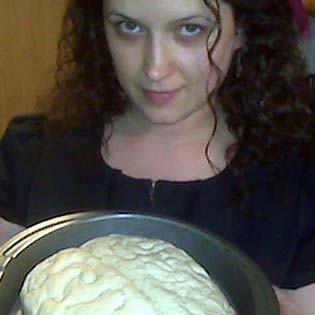 When I was exploring the possibility of a human genetic precursor that was random-handed with a larger brain encouraged by a song-and-dance-based matrifocal culture, I hypothesized that if representatives of our ancestors were around today, they would have larger brains and difficulty with language.
When I was exploring the possibility of a human genetic precursor that was random-handed with a larger brain encouraged by a song-and-dance-based matrifocal culture, I hypothesized that if representatives of our ancestors were around today, they would have larger brains and difficulty with language.
The premise is that the exponential growth in brain size through the history of Homo erectus and before was driven by the selection for mates talented in dance. An established biological pattern is that predators have larger brains than their prey. More demanding physicality (it’s more difficult to be a predator than to run away) creates a requirement for increased neurological support. Dance may have been a sexually selected physical demand with no upward threshold in satisfactory results. Rampant brain growth may have been the result of males competing for the attention of females in matrifocal societies where males that exhibited neotenous characteristics (creative, playful, cooperative) were the most likely males to procreate.
The best dancers had bigger brains. The best way to select for bigger brains over time was to choose males exhibiting neotenous characteristics. Neotenous males are cooperative males supporting a matrifocal social structure.
When I was first monkeying around with these ideas, noting that studies reported that our brains were growing smaller in size about 25,000 years ago, I surmised that an emergence of patrifocal social structure, right-handedness and a smaller brain might be all related. If this was the case, then there might be representatives of language-challenged, bigger-brained people around. I had worked with autistic children. I investigated the literature for evidence of autistic people having bigger brains.
Autistic people have bigger brains. Twenty percent in the 95 percentile.
I then began to explore the literature for evidence of other signs.
Chimpanzees and gorillas exhibit the extremes of the great ape social structure. Chimp males have large testicles to be able to produce the prodigious amounts of sperm required to sire a child. A female in estrous may copulate with several males in a day. Gorillas have small testicles. The male silverback controls the females by physically dominating the other males. He can copulate at his leisure, relatively certain the progeny will be his. Less sperm required. I hypothesized that in a matrifocal social structure, balls would have to be bigger than in a patrifocal set-up. There was some support of this in the literature in contemporary cultures. Highly stratified patrilineal cultures, as a rule, had males with smaller testes than males with more recent matrilineal connections.
The question was: Did bigger-brained males also have larger testicles? Did ambidextrous males, left-handed males or autistic males–hypothesized to be males with an older genotype from matrifocal societies–have bigger balls?
Culling through hundreds of papers, I was unable to find any studies on testicle size as it relates to handedness, autism or conditions characterized by maturational delay. There was one exception. Autistic males with the condition called fragile X had huge testicles. But these autistic males were a genetic anomaly. Is this is a clue?
Consider that with the exponential increase in autistic children, we are seeing a resurgence of individuals with no communicative impairments that are close genetic relations to people with conditions characterized by extreme maturational delay or autism. Look for unusually articulate, big-brained, big-balled, non hierarchical, artistic, left-handed pattern manipulators.
Do those with Aspergers have bigger balls?
…
Proceed to author’s FREE book download on this subject (The book is called Evolution, Autism and Social Change). 10 minute introductory video here.
Andrew Lehman on 10/14/09 in Evolution, featured | 2 Comments | Read More
Comments (2)


To the author: As an articulate, non hierarchical, artistc, left-handed pattern manipulator I really like what the author has to say. Not sure about the “big” stuff, never measured. Please write more.
My genitals are somewhat above average, but testicles are proportionally normal.